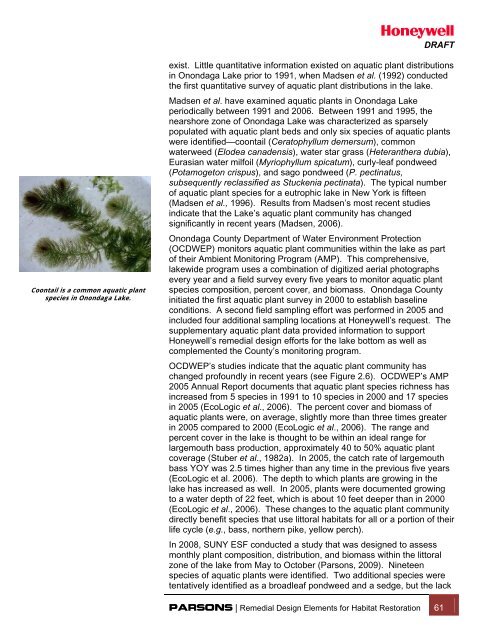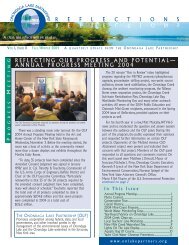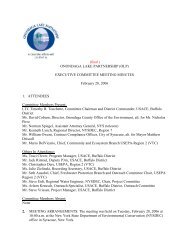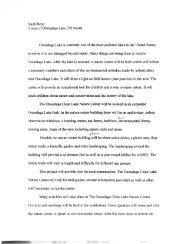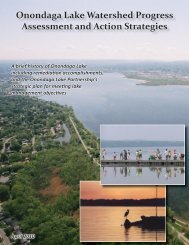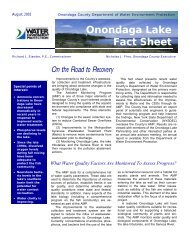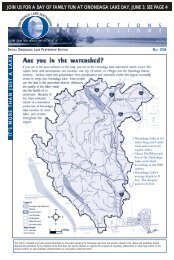Habitat Plan 2 - Onondaga Lake Partnership
Habitat Plan 2 - Onondaga Lake Partnership
Habitat Plan 2 - Onondaga Lake Partnership
Create successful ePaper yourself
Turn your PDF publications into a flip-book with our unique Google optimized e-Paper software.
DRAFTCoontail is a common aquatic plantspecies in <strong>Onondaga</strong> <strong>Lake</strong>.exist. Little quantitative information existed on aquatic plant distributionsin <strong>Onondaga</strong> <strong>Lake</strong> prior to 1991, when Madsen et al. (1992) conductedthe first quantitative survey of aquatic plant distributions in the lake.Madsen et al. have examined aquatic plants in <strong>Onondaga</strong> <strong>Lake</strong>periodically between 1991 and 2006. Between 1991 and 1995, thenearshore zone of <strong>Onondaga</strong> <strong>Lake</strong> was characterized as sparselypopulated with aquatic plant beds and only six species of aquatic plantswere identified—coontail (Ceratophyllum demersum), commonwaterweed (Elodea canadensis), water star grass (Heteranthera dubia),Eurasian water milfoil (Myriophyllum spicatum), curly-leaf pondweed(Potamogeton crispus), and sago pondweed (P. pectinatus,subsequently reclassified as Stuckenia pectinata). The typical numberof aquatic plant species for a eutrophic lake in New York is fifteen(Madsen et al., 1996). Results from Madsen’s most recent studiesindicate that the <strong>Lake</strong>’s aquatic plant community has changedsignificantly in recent years (Madsen, 2006).<strong>Onondaga</strong> County Department of Water Environment Protection(OCDWEP) monitors aquatic plant communities within the lake as partof their Ambient Monitoring Program (AMP). This comprehensive,lakewide program uses a combination of digitized aerial photographsevery year and a field survey every five years to monitor aquatic plantspecies composition, percent cover, and biomass. <strong>Onondaga</strong> Countyinitiated the first aquatic plant survey in 2000 to establish baselineconditions. A second field sampling effort was performed in 2005 andincluded four additional sampling locations at Honeywell’s request. Thesupplementary aquatic plant data provided information to supportHoneywell’s remedial design efforts for the lake bottom as well ascomplemented the County’s monitoring program.OCDWEP’s studies indicate that the aquatic plant community haschanged profoundly in recent years (see Figure 2.6). OCDWEP’s AMP2005 Annual Report documents that aquatic plant species richness hasincreased from 5 species in 1991 to 10 species in 2000 and 17 speciesin 2005 (EcoLogic et al., 2006). The percent cover and biomass ofaquatic plants were, on average, slightly more than three times greaterin 2005 compared to 2000 (EcoLogic et al., 2006). The range andpercent cover in the lake is thought to be within an ideal range forlargemouth bass production, approximately 40 to 50% aquatic plantcoverage (Stuber et al., 1982a). In 2005, the catch rate of largemouthbass YOY was 2.5 times higher than any time in the previous five years(EcoLogic et al. 2006). The depth to which plants are growing in thelake has increased as well. In 2005, plants were documented growingto a water depth of 22 feet, which is about 10 feet deeper than in 2000(EcoLogic et al., 2006). These changes to the aquatic plant communitydirectly benefit species that use littoral habitats for all or a portion of theirlife cycle (e.g., bass, northern pike, yellow perch).In 2008, SUNY ESF conducted a study that was designed to assessmonthly plant composition, distribution, and biomass within the littoralzone of the lake from May to October (Parsons, 2009). Nineteenspecies of aquatic plants were identified. Two additional species weretentatively identified as a broadleaf pondweed and a sedge, but the lackPARSONS | Remedial Design Elements for <strong>Habitat</strong> Restoration 61


